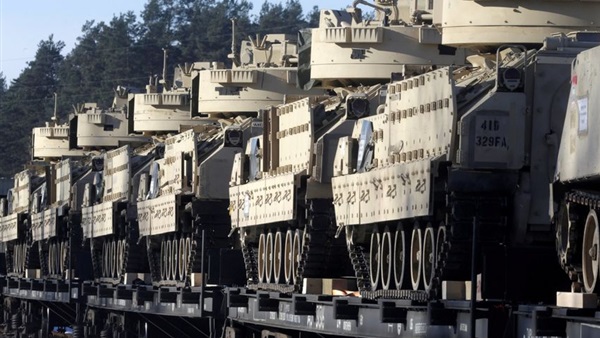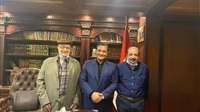Shipments of Armored Vehicles Reflect West’s Growing Confidence in Ukrainian Arms

The arrival of armored vehicles from the U.S. and allies on
the battlefield in Ukraine is designed to bolster Kyiv’s momentum in the war as
well shore up defenses, as U.S. officials anticipate another Russian offensive
when the ground thaws.
The latest aid package, announced Friday, is the largest
yet. It includes for the first time dozens of Bradley Fighting Vehicles that
can carry troops and new artillery pieces that don’t need to be towed.
The type of vehicles, artillery and weapons provided
illustrates the U.S.’s growing confidence in Ukraine’s ability to train on,
operate and effectively maintain the complex advanced vehicles, U.S. officials
said. And it is a recognition that the fight has shifted to a front line
contested by armored infantry. That comes after an initial phase of the war,
almost a year ago, of dueling and fluid artillery battles followed by a more
recent phase characterized by Russian air attacks and Ukrainian air defense.
On Friday, the Biden administration revealed details of a
$3.75 billion package of security assistance from the U.S. and its allies,
which includes Bradley Fighting Vehicles, self-propelled artillery, Humvees and
hundreds of thousands of rounds of ammunition. The arrival of about 50
Bradleys—a highly maneuverable, tracked vehicle—can help Ukrainian forces
conduct more complex operations to target Russian positions, including Russian
tanks, with its complement of firepower.
The deployment of the Bradleys has raised questions again
about why the Biden administration appears slow to send weaponry and other
military gear to Ukraine long after its forces have stunned the West with their
success on the battlefield and requested more advanced gear.
“This is the right time for Ukraine to take advantage of its
capabilities to change the dynamic on the battlefield,” Laura Cooper, a senior
policy official at the Pentagon, told reporters Friday. “And from a maintenance
and sustainment standpoint—and this is really important—the Ukrainians have
demonstrated a lot of growing proficiency.”
As the war has progressed—and Ukraine has pushed Russian
troops back from Kyiv, out of Kherson, and back from the high-water mark of its
invasion of Ukraine’s eastern Donbas region, the U.S. and its allies have given
evermore advanced and lethal weaponry, often fulfilling long-outstanding
requests from Kyiv.
White House officials say Ukraine is getting what it needs
at the moment. The U.S. is also making decisions based on what it believes
Ukrainian forces can train on and maintain, as well as the costs. But as
Ukrainian forces become better at maintaining military gear, the U.S. is more
inclined to provide it, U.S. officials said.
Since Ukrainian forces will require training on how to use
Bradleys, they likely won’t be on the battlefield for “a couple of months,” Ms.
Cooper said.
Ukrainian officials and some former U.S. officials,
meanwhile, have said the Western allies have been too slow to provide Kyiv
advanced weaponry.
“They are taking too long, I don’t understand why we are
spooning out these packages of support versus pushing them forward,” said Ben
Hodges, a retired Army general who led the Army’s Europe command. “Ukrainians
are much more capable than some in D.C. are giving them credit.”
As the U.S. decides to move forward with new kinds of
equipment, so do many European allies. Those countries have long followed
President Biden’s lead. After the U.S. said it would send howitzer artillery
systems, Germany sent howitzers; when the U.S. sent rocket launchers, the
Germans sent rocket launchers. The Germans said they would send a Patriot
antimissile system following Washington’s announcement last month.
Germany has even prepared its main battle tank, the Leopard,
for possible deployment to Ukraine, but has awaited a decision by Mr. Biden to
send American-made Abrams tanks.
“We do what Biden does,” says a top German official.
The decision on the Bradley was no different, with Mr. Biden
announcing the Bradleys and German Chancellor Olaf Scholz pledging the German
equivalent, Marder combat vehicles, at the same time after the two talked
Thursday. Germany made an initial pledge of 40 Marders, and France separately
agreed to send Ukraine AMX-10 light tanks.
In recent weeks, European and Ukrainian diplomats have said
they fear a new Russian offensive against Ukraine in coming months, including a
second attempt to take Kyiv.
Military analysts said the new combat vehicles could play an
important role in future Ukrainian offensives or to defend against a Russian
offensive. The vehicles enable troops to move rapidly around the battlefield
with significant armored protection from enemy artillery and small-arms fire. A
“tank-killer,” in one Pentagon official’s words, the Bradleys are also equipped
with TOW antitank weapons and a 25mm gun.
Ukrainian officials have been pressing for up to 700
infantry fighting vehicles as well as more tanks and howitzers. The U.S. holds
many Bradleys in its fleet, and U.S. officials said the 50 announced on Friday
may be just the beginning. Abrams tanks remain on the table, but they are also
“gas guzzlers,” Ms. Cooper said Friday, and require higher levels of
maintenance than the Bradley. That has contributed to the decision thus far not
to deploy Abrams tanks.
Ben Barry, a former British tank commander now with the
International Institute for Strategic Affairs in London, said the Bradleys and
Marders could be decisive if delivered in sufficient numbers.
“Those Bradleys promise to seriously improve the
effectiveness of Ukraine’s mechanized infantry and are more than a match for
any of the other infantry fighting vehicles that Russia has in Ukraine,” he
said. “The Russian army will be really quite worried about them.”







